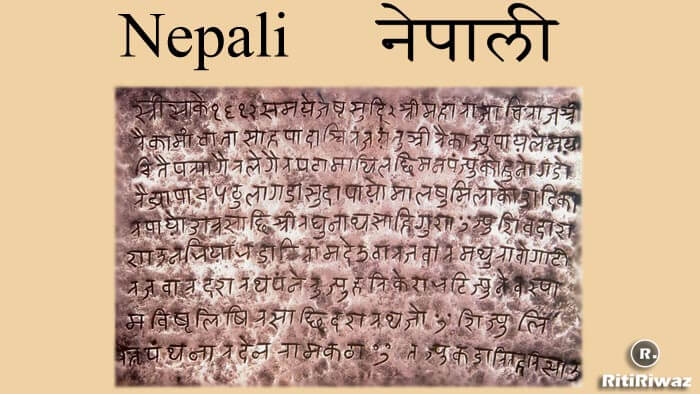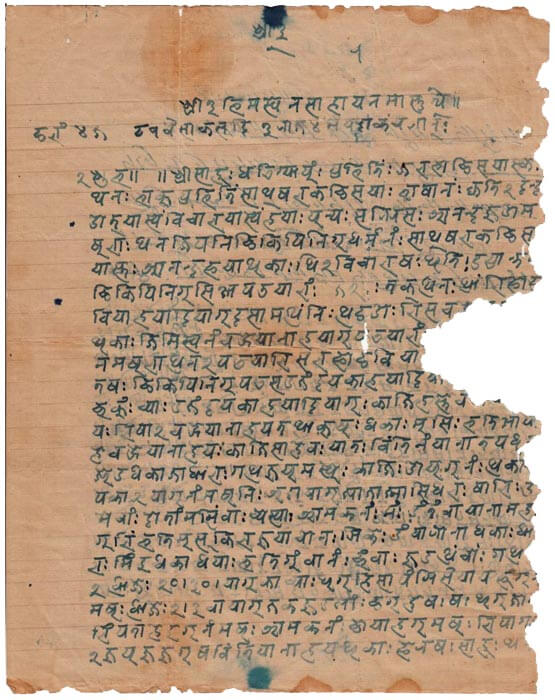Nepali Language

Nepali Language (नेपाली) is the Indo-Aryan language of the sub-branch of Eastern Pahari. It is the language of Nepal and also one of the 22 scheduled languages of India. The languages of the Pahari group are spread along the Himalayan region from the west of Himachal Pradesh to Sikkim in the east and Nepali is the only representative of the Eastern Pahari subgroup. Nepali/Gorkhali is also spoken in India, particularly in the North of this large land.
You will hear Nepali in Assam, Arunachal Pradesh, Meghalaya, Nagaland, Sikkim, Tripura, and West Bengal. Nepali is written with the Devanagari script. Within Indian perimeters, Nepali is the official language of the state of Sikkim and also the Darjeeling district of the eastern state of West Bengal.
The Nepali language was first called the Khas language (Khas kurā), then Gorkhali or Gurkhali (the language of the Gorkha Kingdom) before the term Nepali (Nepālī bhāṣā) was taken from Nepal Bhasa. Other names include Parbatiya. In Sikkim 80% of people use Nepali as their main language, this language also called Pahadi, Parbate, Gorkhali language, it is the origin of Devanagari Script. Nepali language just similar to the Hindi language and both is Indo-Aryan languages. They follow the same script which is the Devanagari script and can be easily understood by Hindi and Urdu speakers.
History of Nepali Language

The origin of the Nepali language has a long history. As it was the language of these Sinja kings, it was initially known as the Sinjali language. In the beginning, Sinja was a very big and powerful country. Apart from Eastern Nepal, the rest of Nepal, including Mansarovar in the north and Kumaon Gadwal in the west, this empire is found to have spread. Its northern region was called Jadan and its southern region Khasan. Bhote Burmese was spoken in the connection area and Sinjali was spoken in the Khasan area. The Sinjali language was the official language of Sinja. But because it was originally the language of the people living in the Khasan area, it was called Khas language or Khaskura.
From the fifteenth century onwards, the Sinja country is gradually falling apart! Around 1466, Mahamandaleshwa (Prime Minister) Yasovarma of Prithvi Malla revolted from Sinja and established his own separate kingdom. Thus, after Sinja, the original and influential area of the speakers of this language probably became a peak point before Gorkha. That is why this language became known as Parvati. This was also the mother tongue of the Shah dynasty of Gorkha. From the time of Prithvi Narayan Shah, the power of the Gorkhas began to increase in the Himalayan kingdoms. The Origin of the Nepali language has its milestone at this point.
As a result, the language spoken by these powerful Gurkhas became known as “Gurkha”. Even though the Gurkhas took Nepal under their control and made it their capital, the name of this language was Gorkhali. The first J. from Calcutta in 1820, A. Eaton wrote the book “A Grammar in Nepali Language” and used the Nepali name for the first time. From about 1918, the name of the language was officially “Nepali”! Although the name of this language is “Nepali” much later, the word Nepal is also mentioned in the economics of Kautilya.
Dialects
There are three major dialects of Nepali: eastern, central, and western. The Nepalese appeared in Sikkim much after the Lepchas and Bhutias. The Nepalese now constitute more than 80 % of the total population. is a language in the Indo-Aryan branch of the Indo-European language family.
Nepali follows the same script as Hindi which is the Devanagari script. The Devanagari script, which is generally known as Nagari, is written from left to right. The order of the letters made up of vowels and consonants is known as the “Varnamala” which means the “garland of flowers, it utilizes consonant-vowel units (e.x. प = pa).
In Nepali there is almost a negligible difference between the sounds /s/ and /sh/, /g/, /jure/, and /f/. Also, the sound of “swah” and /^/ are the same. The Nepali language lacks articles. The nouns are either masculine or feminine. Nepali distinguishes between existential and definitive functions of the verb “to be.” For instance, “pānī ho?” means “is this water?” while “pānī cha?” means “is there any water?” It also uses numeral classifiers as in “tīnjanā mānche,” which means “three men pointing towards a person.” When talking about an object such as a chair, we have the verb “tīnva ā mec” which means “three chairs.”
The script of Nepali Language
Nepali is commonly written in the Devanagari script, as are Hindi and Sanskrit. There is some record of using Takri script in the history of Nepali, especially in western Nepal, Uttarakhand, and Himachal Pradesh. Bhujimol is an older script native to Nepal, while Ranjana script is another writing system historically used.
Nepali developed a significant literature within a short period of hundred years in the 19th century, fueled by Adhyatma Ramayana; Sundarananda Bara (1833); Birsikka, an anonymous collection of folk tales; and a version of the South Asian epic Ramayana by Bhanubhakta. The contribution of trio-laureates Poudyal, Devkota, and Sama took Nepali to the level of other world languages. The contribution of expatriate writers outside Nepal, especially in Darjeeling and Varanasi, is also notable.
Salient Features of Nepali Language
- All nouns are masculine and feminine
- Articles are not present in their language
- The English suffix “less” is often used with Nepali words.
Unlike Hindi, Nepali distinguishes between existential (chanu) and definitive (hunu) functions of the verb „to be‟, e.g., pānī ho? „is this water?‟, pānī cha? „is there [any] water?‟
Like Bengali, it uses numeral classifiers, e.g., tīnjanā mānche „three [-person] men‟, tīnva ā mec „three [-object] chairs‟ and accords feminine gender only to female human nouns. It forms most plural nouns through the affixation of harū; and generally forms negative verbs by the adaptation of verb endings, e.g., ma jānchu „I go‟, ma j dina „I do not go‟.
Four honorific grades plus a royal honorific are available for personal pronouns. The use of infinitives and participles commonly links clauses and seldom by conjunctions: thus, H. vah ādmī jo kal āyā „the man who came yesterday‟ is Ne. hijo āeko mānche „the yesterday having-come man‟.
Nepali and Hindi
Among the other major Indo-Aryan languages, Hindi is Nepali‟s the closest cousin, and many literate Nepali speakers are proficient in Hindi. However, in its everyday vocabulary Nepali preserves many Sanskrit and Sanskrit-derived words (e.g., ghām ‘sun‟, khukurā ‘chicken‟, ritto ‘empty‟) that have been displaced by Perso-Arabic loans in Hindi, and the Arabic and PersoArabic element of its lexicon is largely confined to the law, war and weaponry, and governance and monarchy. Similarly, English loans are generally less common in Nepali than in Hindi, partly because Nepal was never colonized by the British.
Suggested Read: Santhali Language






